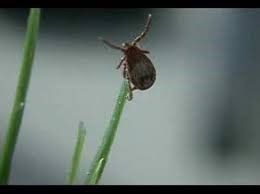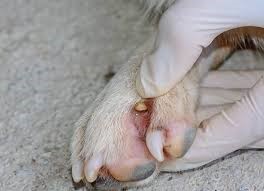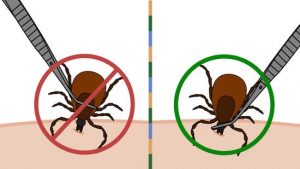Going for a hike in the mountains? Taking a swim in the lake? Spending extended time outside on a beautiful day? Keep in mind your furry loved ones are the perfect hiding spot for pesky little critters like ticks. Knowing how to check for them and remove them is extremely important.

When and Where to Check for Ticks

To protect your pets against transmitted diseases, it is important to regularly check them for ticks even if you use preventative care. Ticks pick a place to wait by identifying well-used paths in nature. Then they wait for a host, resting on the tips of grasses and shrubs. Ticks can’t fly or jump, but many tick species wait in a position known as “questing”.
While questing, ticks hold onto leaves and grass by their third and fourth pair of legs. They hold the first pair of legs outstretched, waiting to climb on to the host. When a host brushes the spot where a tick is waiting, it quickly climbs aboard. Some ticks will attach swiftly and others will wander, looking for moist dark places like the ear, the groin, between toes, under your pet’s collar, under the tail or other areas where the skin is thinner.
Be sure to check your pet any time they may have come in contact with lesser traveled over grown vegetation. For example, after a hike in the woods, a swim in the local river or a run through the park. Be thorough and take your time. Most deer ticks are about the size of sesame seed and other types are no bigger than a grain of salt, so it is important not to rush and check all the above areas carefully.
How to Check for Ticks
A thorough examination of your pet is vital in helping reduce the risk of disease that can be transmitted from a latched tick. Always take your time and pay extra attention when examining for these pesky buggers.
Step 1: Have your pet sit down.
- If your pet is small, it may be a good idea to place them on a towel on top of a table or counter.
Step 2: Gently and thoroughly run your hands over your pet’s body.

- Begin with the face and ears and work your way back towards the tail.
Step 3: Check the chest, stomach, legs, and feet.
- Pay special attention to the “armpits,” between the toes, and inside the ears as these are common places for ticks to hide.
Step 4: Feel lumps or bumps? Spot irritation?
- Separate the fur and get a closer look to determine whether a tick is present. If you have found a tick, it may have already formed a protective sac around its body. This means it has been feeding on your pet already and it is important that you remove it properly to avoid any further risk of transmitting disease.
How to Remove a Tick

Step 1: Use a clean pair of tweezers to gently grasp the sac
- Use fine-tipped tweezers to grasp the tick as close to the skin’s surface as possible.
Step 2: Pull the sac away from the skin
- Pull upward with steady, even pressure.
- Do not twist or jerk the tick. This can cause the mouth-parts to break off and remain in the skin. If this happens, remove the mouth-parts with tweezers. If you are unable to remove the mouth easily with clean tweezers, leave it alone and let the skin heal.
- Never squeeze, crush, or puncture the body of tick. Doing so may cause the tick to release fluids containing infectious bacteria.
- Avoid using petroleum jelly, a hot match, nail polish, or any other product to remove a tick! Your goal is to remove the tick as quickly as possible–not waiting for it to detach. Plus, these products can cause the tick to release saliva, making the risk for contracting a disease much higher.
Step 3: Dispose of the tick
- Never crush a tick with your fingers.
- Put it in alcohol and place it in a sealed bag/container, wrap it tightly in tape or flush it down the toilet.
- You may also bring the tick to the Health Department’s administration building for identification purposes.
Step 4: Sterilize
- Thoroughly clean the bite area and your hands with rubbing alcohol or soap and water.
Step 5: Watch for signs of infection
- Keep a close eye on the affected area. A red spot and/or slight swelling are normal. However, if you notice serious redness, extensive swelling, tenderness, lameness, fever, severe irritation, or loss of appetite contact your veterinarian immediately!




Leave a Reply